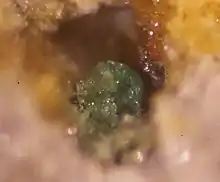Tripuhyite
Tripuhyite is an iron antimonate mineral with composition FeSbO4.
| Tripuhyite | |
|---|---|
 | |
| General | |
| Category | Antimonate mineral |
| Formula (repeating unit) | FeSbO4 |
| Strunz classification | 4.DB.05 |
| Crystal system | Tetragonal |
| Crystal class | Ditetragonal dipyramidal (4/mmm) H-M symbol: (4/m 2/m 2/m) |
| Space group | P41/mnm |
| Unit cell | a = 4.63, c = 9.14 [Å]; Z = 2 |
| Identification | |
| Color | Yellowish brown, lemon-yellow, brown-black |
| Crystal habit | Fibrous to fine-grained aggregates |
| Mohs scale hardness | 6 - 7 |
| Luster | Dull to earthy |
| Streak | Canary-yellow to dark brown with a greenish tinge |
| Diaphaneity | Translucent |
| Specific gravity | 5.82 |
| Optical properties | Uniaxial (+), canary-yellow color (transmitted light) |
| Refractive index | nω = 2.190 nε = 2.330 |
| Birefringence | δ = 0.140 |
| Pleochroism | None |
| Solubility | Insoluble in acids |
| Other characteristics | Antiferromagnetic |
| References | [1][2][3] |
Nomenclature
The name of the mineral comes from the locality of Tripuhy, Ouro Preto, Minas Gerais, Brazil, where it was discovered. Hussak and Prior[4] first described the mineral tripuhyite as an oxide of iron and antimony, and assigned it the composition Fe2Sb2O7. When a mineral with composition FeSbO4 was later discovered in Squaw Creek, New Mexico (US), it was considered erroneously as a new mineral and it was given the name squawcreekite.[5] However, other studies had shown that the original tripuhyite was also FeSbO4.[6] In 2002, the Commission on New Minerals and Mineral Names (CNMMN) of the International Mineralogical Association (IMA), approved the redefinition of tripuhyite as FeSbO4 and the discreditation of squawcreekite.[7]
Crystal Structure
FeSbO4 exhibits the rutile structure, with a tetragonal unit cell. The cations are octahedrally coordinated to oxygen anions, with the octahedra sharing edges along the c-direction. Fe(III) and Sb(V) cations are distributed in a disordered way over the octahedral sites.
References
- Mindat.org
- Handbook of Mineralogy
- Webmineral data
- Hussak, E.; Prior, G. T. (1897). "On Tripuhyite, a New Antimonate of Iron, from Tripuhy, Brazil". Mineralogical Magazine. 11: 302–303. doi:10.1180/minmag.1897.011.53.04.
- Foord, E. E.; P. F. Hlava; J. J. Fitzpatrick; R. C. Erd; R. W. Hinton (1991). Neues Jahrbuch für Mineralogie - Monatshefte. 8: 363–384. Missing or empty
|title=(help) - Tavora, E. (1955). "X-ray diffraction powder data for some minerals from Brazilian localities". Anais da Academia Brasileira de Ciências. 27: 7–27.
- Berlepsch, P.; T. Armbruster; J. Brugger; A. J. Criddle; S. Graeser (2003). "Tripuhyite, FeSbO4, revisited". Mineralogical Magazine. 67: 31–46. doi:10.1180/0026461036710082.
Bibliography
- Palache, P.; Berman H.; Frondel, C. (1960). "Dana's System of Mineralogy, Volume II: Halides, Nitrates, Borates, Carbonates, Sulfates, Phosphates, Arsenates, Tungstates, Molybdates, Etc. (Seventh Edition)" John Wiley and Sons, Inc., New York, pp. 1024.